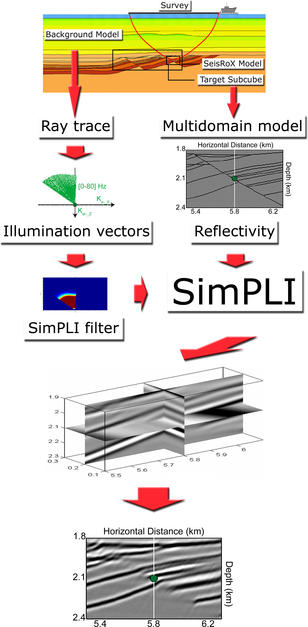SimPLI
Fast, flexible and robust simulation of 2D/3D PSDM images
The SimPLI™ approach is a new concept (developed and patented by NORSAR) for modelling the seismic response of hydrocarbon reservoirs. By deriving the SimPLI filters (which represent the total illumination and resolution effects of a survey/overburden combination) and combining these with the reflectivity output of the multi-domain model, a 2D/3D simulated seismic PSDM image of the structure in the local target can be obtained. This allows an interpreter to rapidly analyse the dynamic reservoir model in terms of seismic response, i.e.PSDM images.
The “Simulated Prestack Local Imaging” concept efficiently estimates prestack depth migrated sections without the need to calculate and process synthetic data. The patented SimPLI method is a generalized convolution technique working in the 2D/3D prestack depth domain. It goes far beyond the classic 1D trace modeling as it enables the user to predict 2D/3D illumination and resolution effects in prestack acquisition. Innovative functionality coupled with pre-defined workflows and a user driven environment make applications numerous. They include, but are not limited to; survey planning, interpretation, time-lapse reservoir studies, seismic imaging and AVO/AVA analyses.
Prestack Depth Migrated (PSDM) sections are the final results of a whole seismic acquisition and processing sequence. Even in modeling studies, synthetic data are usually calculated before being processed and then pre stack depth-migrated.
SimPLI considers a prestack depth migrated section as a filtered version of the Earth’s structure where the filter is locally described by the available wavenumber vectors (Hamran and Lecomte, 1993, Lecomte and Gelius, 1998, Gelius et al, 2002, Lecomte et al, 2001, 2003a). This removes the need to go through the classic process of combining synthetic-data generation and prestack depth migration to get the migrated version of the structure.
Once a SimPLI filter has been created for a given survey (including source effects) and overburden, the physical properties of the target can be altered and a sequence of different model hypotheses can be rapidly generated. This can be done on a standard laptop in moments giving the user the tools to efficiently quantify the influence of the physical properties on their seismic image. As opposed to Standard 1D convolution ( poststack time-domain), the SimPLI filter works directly in the prestack depth domain and contains the effect of illumination as well as lateral and vertical resolution so that the simulated image accurately represents the final PSDM image.
 SimPLI workflow
SimPLI workflow
SimPLI™ allows an interpreter to analyze the dynamic reservoir model by quickly simulating PSDM images which take into account survey characteristics, overburden effects and the reservoir properties. The survey and overburden are represented by a set of scattering wavenumber vectors. For selected locations in the subsurface, the illumination vectors are determined for each pair of source and receivers in the survey. This can be done by ray tracing prior to the analysis, and is only done once for each survey. The illumination vectors are selected according to the offset or angle intervals chosen by the interpreter. The user may also define the frequency band of interest using a given pulse. The illumination vectors and chosen wavelet are used to make the SimPLI filters. These filters are applied to reflectivity grids (exported from the multi-domain model) to obtain simulated PSDM images in 2D or 3D.
This workflow is summarized in the Figure. Using the background model, illumination vectors are calculated by ray tracing from the point of interest within the target subcube. The SimPLI filter is created by combining these vectors with the source pulse. The filter is combined with the output from the multi-domain model (reflectivity data) in SimPLI to simulate the 3D PSDM image.